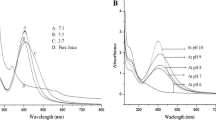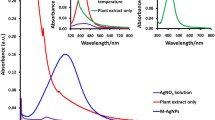Abstract
Heavy metals that are part of our environment have an undeniably negative impact on human life and the ecosystem due to their inherent toxicity. Mercury (Hg) is an omnipresent heavy metal that has gained the exceptional attention of researchers due to its deleterious effects on the ecosystem as well as human health. In this study, highly sensitive acyclovir stabilized silver nanoparticles (AC–AgNPs) were synthesized using a chemical reduction method and were characterized using ultraviolet–visible (UV–vis) spectroscopy, as well as other characterization techniques such as Fourier transform infrared (FTIR) spectroscopy, atomic force microscopy (AFM), and dynamic light scattering (DLS). The synthesized AC–AgNPs were of small size (44.1 nm) with uniform size distribution (PDI = 0.8), uniform morphology and had − 17.4 mV zeta potential. The AC–AgNPs were used to detect Hg2+ spiked in deionized, river, seawater, and human blood plasma samples. The nanosensor was highly selective for sensing of Hg2+ even in the presence of other competing metal ions, a concentrated solution of electrolyte (2 M), a wide range of pH (5–14), and human blood plasma. The Jobs plot experiment showed 1:2 binding stoichiometry between AC–AgNPs and Hg2+ with a limit of detection of 0.00035 mM. Results of this study show that the synthesized nanoparticles have the potential to be used for the development of a new colorimetric sensor for selective and easy detection of Hg2+ ions in different media.












Similar content being viewed by others
Data and material availability
Data measured and materials used in this research are included in the main text of the paper.
References
Abeywickrama CJ, Wansapala J (2019) Review of organic and conventional agricultural products: Heavy metal availability, accumulation and safety. Int J Food Sci Nutr 4(1):77–88
Ahmed F, Kabir H, Xiong H (2020) Dual colorimetric sensor for Hg2+/Pb2+ and an efficient catalyst based on silver nanoparticles mediating by the root extract of bistorta amplexicaulis. Front Chem. https://doi.org/10.3389/fchem.2020.591958
Ahmed F et al (2021) Synthesis and characterization of a plant growth regulator based silver nanoparticles for the ultrasensitive detection of environmentally toxic Hg 2+ ions in tap water. New J Chem 45(38):18039–18047
Amendola V et al (2006) Light-emitting molecular devices based on transition metals. Coord Chem Rev 250(3–4):273–299
Ball RL, Bajaj P, Whitehead KA (2017) Achieving long-term stability of lipid nanoparticles: examining the effect of pH, temperature, and lyophilization. Int J Nanomed 12:305
Bandi R et al (2020) Rapid synchronous synthesis of Ag nanoparticles and Ag nanoparticles/holocellulose nanofibrils: Hg (II) detection and dye discoloration. Carbohydr Polym 240:116356
Björkman L et al (2007) Mercury in human brain, blood, muscle and toenails in relation to exposure: an autopsy study. Environ Health 6(1):1–14
Chen J et al (2009) Determination of ultra-trace amount methyl-, phenyl-and inorganic mercury in environmental and biological samples by liquid chromatography with inductively coupled plasma mass spectrometry after cloud point extraction preconcentration. Talanta 77(4):1381–1387
Chen L et al (2013) Highly sensitive and selective colorimetric sensing of Hg2+ based on the morphology transition of silver nanoprisms. ACS Appl Mater Interfaces 5(2):284–290
Chen G et al (2015) Fluorescent and colorimetric sensors for environmental mercury detection. Analyst 140(16):5400–5443
Choi K-O, Aditya N, Ko S (2014) Effect of aqueous pH and electrolyte concentration on structure, stability and flow behavior of non-ionic surfactant based solid lipid nanoparticles. Food Chem 147:239–244
Cui X et al (2015) A fluorescent biosensor based on carbon dots-labeled oligodeoxyribonucleotide and graphene oxide for mercury (II) detection. Biosens Bioelectron 63:506–512
Davidson PW, Myers GJ, Weiss B (2004) Mercury exposure and child development outcomes. Pediatrics 113(Supplement 3):1023–1029
Grandjean P et al (1998) Cognitive performance of children prenatally exposed to “safe” levels of methylmercury. Environ Res 77(2):165–172
Guo S et al (2018) A colorimetric and fluorescent chemosensor for Hg 2+ based on a photochromic diarylethene with a quinoline unit. RSC Adv 8(70):39854–39864
Guzzi G, La Porta CA (2008) Molecular mechanisms triggered by mercury. Toxicology 244(1):1–12
Han FX et al (2006) Rapid determination of mercury in plant and soil samples using inductively coupled plasma atomic emission spectroscopy, a comparative study. Water Air Soil Pollut 170(1):161–171
Harris HH, Pickering IJ, George GN (2003) The chemical form of mercury in fish. Science 301(5637):1203–1203
Huang X et al (2007) Gold nanoparticles: interesting optical properties and recent applications in cancer diagnostics and therapy. Nanomedicine 2(5):681–693
Huynh KA, Chen KL (2011) Aggregation kinetics of citrate and polyvinylpyrrolidone coated silver nanoparticles in monovalent and divalent electrolyte solutions. Environ Sci Technol 45(13):5564–5571
Iqbal M et al (2020) Green synthesis of silver nanoparticles from Valeriana jatamansi shoots extract and its antimicrobial activity. Green Process Synth 9(1):715–721
Jeevika A, Shankaran DR (2016) Functionalized silver nanoparticles probe for visual colorimetric sensing of mercury. Mater Res Bull 83:48–55
Kamali KZ et al (2016) Amalgamation based optical and colorimetric sensing of mercury (II) ions with silver@ graphene oxide nanocomposite materials. Microchim Acta 183(1):369–377
Khan B et al (2018) Synthesis and characterisation of calix [4] arene based bis (triazole)-bis (hexahydroquinoline): probing highly selective fluorescence quenching towards mercury (Hg2+) analyte. J Hazard Mater 347:349–358
Li H, Bian Y (2009) Selective colorimetric sensing of histidine in aqueous solutions using cysteine modified silver nanoparticles in the presence of Hg2+. Nanotechnology 20(14):145502
Li C et al (2011) Facile synthesis of concentrated gold nanoparticles with low size-distribution in water: temperature and pH controls. Nanoscale Res Lett 6(1):1–10
Li D et al (2014) Gold nanoparticles decorated carbon fiber mat as a novel sensing platform for sensitive detection of Hg (II). Electrochem Commun 42:30–33
Maruthupandi M, Vasimalai N (2021) Nanomolar detection of L-cysteine and Cu2+ ions based on Trehalose capped silver nanoparticles. Microchem J 161:105782
Mermer Z et al (2021) Architecture of multi-channel and easy-to-make sensors for selective and sensitive Hg2+ ion recognition through Hg–C and Hg-N bonds of naphthoquinone-aniline/pyrene union. J Hazard Mater 410:124597
Ravi SS et al (2013) Green synthesized silver nanoparticles for selective colorimetric sensing of Hg 2+ in aqueous solution at wide pH range. Analyst 138(15):4370–4377
Risher JF et al (1999) Summary report for the expert panel review of the toxicological profile for mercury. Toxicol Ind Health 15(5):483–516
Sardans J, Montes F, Peñuelas J (2010) Determination of As, Cd, Cu, Hg and Pb in biological samples by modern electrothermal atomic absorption spectrometry. Spectrochim Acta, Part B Atomic Spectrosc 65(2):97–112
Sastry M, Patil V, Sainkar S (1998) Electrostatically controlled diffusion of carboxylic acid derivatized silver colloidal particles in thermally evaporated fatty amine films. J Phys Chem B 102(8):1404–1410
Ullah A et al (2019) Synthesis and characterization of peptide-conjugated silver nanoparticle for selective detection of Hg2+ in human blood plasma and tap water. J Mol Liq 296:112095
Wang Y, Yang F, Yang X (2010) Colorimetric biosensing of mercury (II) ion using unmodified gold nanoparticle probes and thrombin-binding aptamer. Biosens Bioelectron 25(8):1994–1998
Wang X et al (2012) Highly sensitive fluorescence probe based on chitosan nanoparticle for selective detection of Hg2+ in water. Colloids Surf, A 402:88–93
Zhang R, Chen W (2014) Nitrogen-doped carbon quantum dots: facile synthesis and application as a “turn-off” fluorescent probe for detection of Hg2+ ions. Biosens Bioelectron 55:83–90
Zhao J et al (2016) Novel electrochemiluminescence of perylene derivative and its application to mercury ion detection based on a dual amplification strategy. Biosens Bioelectron 86:720–727
Acknowledgements
All the authors are thankful to the International Center for Chemical and Biological Sciences (ICCBS), University of Karachi, Pakistan, for providing research facilities.
Funding
This research got no funding from any source.
Author information
Authors and Affiliations
Corresponding author
Ethics declarations
Conflict of interest
All the authors declare that they have no financial or any other competing interests.
Additional information
Editorial responsibility: Fatih Şen.
Rights and permissions
About this article
Cite this article
Ullah, I., Ali, I., Ullah, S. et al. Synthesis of acyclovir stabilized silver nanoparticles for selective recognition of Hg2+ in different media. Int. J. Environ. Sci. Technol. 19, 11279–11290 (2022). https://doi.org/10.1007/s13762-021-03880-4
Received:
Revised:
Accepted:
Published:
Issue Date:
DOI: https://doi.org/10.1007/s13762-021-03880-4




